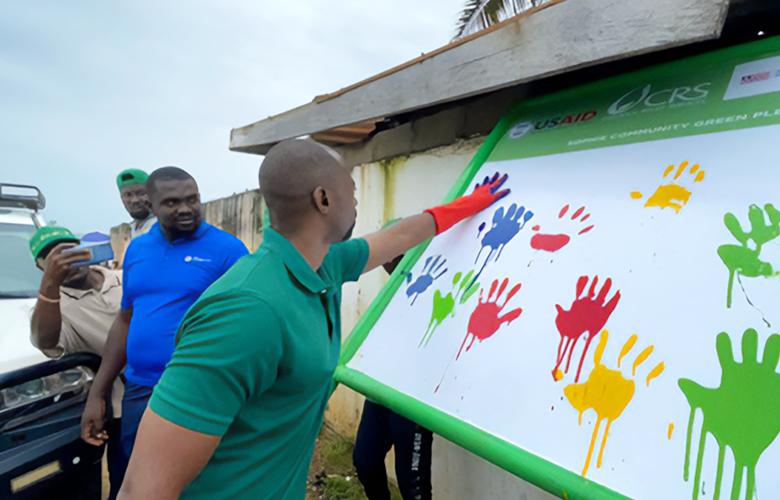
Steve Kamanzi is the chief of party of the Liberia Youth Advance Project with EDC. Prior to that, he led the Huguka Dukore Akazi Kanoze (HDAK) project, which strengthened the capacity of local organizations and stakeholders in Rwanda to provide workforce readiness and engagement support to over 40,000 out-of-school youth in 25 districts of Rwanda. He also led system strengthening efforts that resulted in the institutionalization of an integrated work readiness and soft skills curriculum within the Rwandan secondary education and the technical and vocational education and training (TVET) systems (under the Akazi Kanoze Project). In the last year, he helped lead the development of an internal strategy for locally led development within EDC’s International Development Division.
In this Q&A session, Kamanzi discusses what locally led development means and why it’s crucial for sustainable impact.
Q. What is locally led development, and why is it important?
Kamanzi: Locally led development is about empowering local organizations to take the lead in the design and implementation of development programs. It is not about us coming in and imposing external solutions; rather, it’s about starting with what local organizations already know and are passionate about. They know their communities, their challenges, and their strengths. Our role is to help them build the capacity to expand their impact and sustain their efforts over time.
For example, in both Rwanda and Liberia, we’ve worked with organizations that focused on youth workforce development. They already had the passion and mission to serve their communities. What they needed from us was support in building their capacity to grow.
Q. Would you say there is a defining feature of EDC’s approach to local capacity strengthening?
Kamanzi: I would say what defines EDC’s approach is our ability to work with organizations by finding them where they are—but not leaving them where we found them.
Our approach is defined by how we engage with local organizations from the start. We begin by understanding their mission and vision. Before signing a memorandum of understanding (MOU) or developing a grant agreement, we sit down with our partners to discuss how our program can help them succeed in their goals. The results of these conversations lead to a relationship that benefits both sides: on the one hand, the relationships with local partners help EDC achieve results and scale, while on the other hand, local organizations see their capacities elevated in areas where they want to serve their communities.
The key success factor here is finding local partners that know their identity—in other words their mission, their heartbeat—you don’t bring it to them. Their “raison-d’etre” is to empower youth with skills, tools, and networks that help them enter the workforce. These organizations may not have all the capacities they need to grow or the ways to amply their results—but having that clear heartbeat helps them in assessing what lack or additional capacities they need to meet their goals.
Q. How does EDC support and elevate local partners?
Kamanzi: At EDC, we ensure that local organizations, regardless of their size or capacity, have a place with us. We’ve developed several pathways and approaches to partnerships that enable small-sized organizations, such as disabled persons organizations (DPOs) and youth-led and women-led groups, to access our capacity-strengthening activities. These activities, which include work readiness and basic education, are often facilitated through MOUs. Many of these organizations may not have the capacity to manage a grant program, but their primary goal is to grow and better serve their communities. They are eager to take advantage of every opportunity and support they can find along the way.
For grant-based partnerships, we tailor our grant programs to support smaller organizations. For example, in Liberia, we designed specific requests for applications (RFAs) that targeted DPOs, recognizing that they may struggle to compete with larger national organizations. By doing so, we ensure that these smaller groups can participate and benefit from the support they need.
While localization may be a priority for USAID, we’ve found that our local partners themselves are driving this demand. There is a great need for capacity-strengthening support, and through our partnerships, we aim to leave organizations in a position where they can continue their work independently and sustainably.
Q. Why is capacity strengthening important for sustainability?
Kamanzi: Local organizations are the ones that will continue the work after a project ends. In Rwanda, we saw this firsthand. Several organizations we partnered with continued to implement the skills they learned through our workforce readiness program long after our project ended. They even secured additional funding on their own, using the skills that they learned. That’s the ultimate goal—to empower local partners to carry the work forward independently.
In Liberia, we’re applying the same principles. We’ve worked with more than 30 small youth-serving organizations that aren’t grant-funded, but they participate in workshops and training sessions to grow their capacity. They’re taking what they learn and bringing it back to their organizations, which helps them continue improving their communities even without direct financial support from us. They also have the opportunity to be part of a wider network of grant-based local partners that learn from one another.
Add new comment